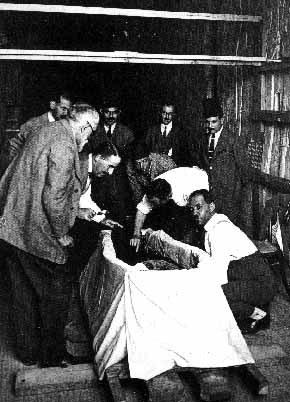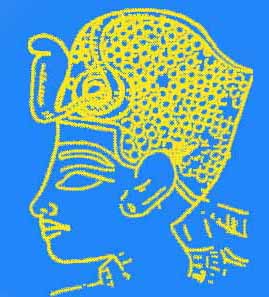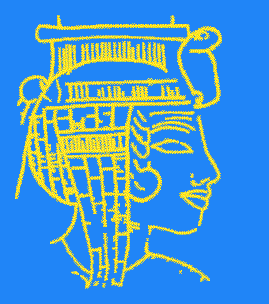pop up description layer
HOME
Cryptozoology UFO Mysteries Aviation Space & Time Dinosaurs Geology Archaeology Exploration 7 Wonders Surprising Science Troubled History Library Laboratory Attic Theater Store Index/Site Map Cyclorama
Search the Site: |
|
The
Death of King Tut: Was it Murder?
In the middle of the night a man moves silently through the halls of the Pharaoh's palace. Avoiding the sentries, he makes his way to the bedroom of the king himself. Entering, he stealthily approaches a form asleep on the bed. The king, still not quite a man, sleeps on his side, unaware of the danger he is in. The man pulls out a heavy weapon and takes careful aim. He strikes one blow to the lower back of the sleeper's skull. There is a sickening thump. The man then moves quietly out of the room, leaving the king to die. The location of this tale is Egypt. The year is 1325 B.C. The Pharoh is King Tut. And intriguing tale, but is it true? Was King Tutankhamen, perhaps the most well-known Pharaoh im Egyptian history, murdered? Egypt Before Tutankhamen When looking back from modern times, we do not often appreciate the long history of ancient Egypt. It is estimated that Tutankhamen was born in 1334 B.C.. Before his birth Pharaohs ruled Egypt for almost 2,000 years. The Egyptian nation, protected from its neighbors by burning desert and nourished by the abundant crops brought by the Nile River, was stable and wealthy in a way that few other ancient societies could match. The first Pharaoh, Narmer, united upper and lower Egypt under him and established the king's office. As head of both the government and religion, the Pharaoh had absolute power in Egypt. The tool he used to enforce his will was the army. Because of the abundance the Nile gave Egypt, the country could afford to build a standing army while most other nations could barely manage to feed themselves. The Pharaoh used this army to subdue bordering nations and establish an empire. They extracted heavy tribute from their neighbors, and any nation not paying up risked having the Egyptian army show up the following year to collect payment in a most unpleasant way. With goods and gold flowing in from other lands the Egyptians became even richer and could afford to take on projects like immense irrigation systems for their fields and extensive tombs for their leaders. A complex religion developed with the Pharaoh (considered a living god) at its center. Temples appeared up and down the Nile and a priesthood employing thousands of men developed. These three important centers of power, the Pharaoh, the military, and the perished, controlled Egypt for most of its history. Their role in Egyptian society though the centuries remained largely unchanged until just a few decades before Tutankhamen's birth. Akhenaten's Break with Tradition Pharaoh Amenhotep III his ruled over Egypt at a time the nation was at the peak of its power and wealth. His armies had extended Egypt's influence as far as Sudan in the south. From there a steady stream of gold enriched the nation's treasury. With it the Pharaoh went on a unprecedented building program extending the great Temple of Amen at Karnak and building and refurbishing other temples, palaces and public buildings, much to the pleasure of the priesthood. When Amenhotep IV came to power after his father's death, however, things changed in Egypt. They changed in a way that was not pleasing to many of the most important people in the land. For reasons that are not completely clear, Amenhotep IV turned his back on the traditional religion of Egypt and turned to worship Aten, the sun disk. Changing his name to Akhenaten, meaning "it is beneficial to Aten," the new Pharaoh moved himself, his family and his government from the traditional capitals at Thebes and Memphis to a new city built in the desert called Amarna. Akhenaten declared he would never leave this new home. Pharaoh Akhenaten's radical changes must have been very upsetting to the Egyptian establishment. The Pharaoh had no interest in wars, so the army was not well maintained. Having decided that he believed in only one god, Aten, he no longer worshiped at, or spend money on, the traditional temples, making the priesthood unhappy. Tutankamen Becomes King
As Akhenaten grew old his son, Smenkare, was groomed to take his place as the new Pharaoh. Then tragedy struck when Smenkare unexpectedly died. The throne needed a new heir. It came in the form of a young boy named Tutankhaten (who would later change his name to Tutankhamen). Scholars debate just what the relationship was between Akhenaten and Tutankhaten, but it seems likely that he was the son of a Akhenaten's second wife, Kiya. Tutankhaten was prepared for the kingship, but he was only ten when Akhenaten died. No more adults of royal blood were left at that point, only Tutankhaten and his half-sister Ankhesenpaaten. Tutankhaten was declared emperor and was married to Ankhesenpaaten. They were both only children, though, and there must have been some powerful figure in Amarna, advising Tutankhaten what to do. Most likely this was a man called Aye. Aye was one of the oldest and powerful of the advisors in Akhenaten court. It seems likely that under his influence the young King decided to abandon the city his father built and return to the traditional capital at Thebes. Aye also appears to be responsible for getting Tutankhaten to change back to supporting the original gods of Egypt instead of following his father's belief in Aten. This resulted in the young Pharaoh's name being changed from Tutankhaten to Tutankhamen. Aye's council on these matters appears to have been politically wise since these changes pleased the powerful priesthood and military leaders. The army was rebuilt and once more ventured into foreign lands to collect tribute, this time under the direction of a general who had risen up through the ranks of the army named Horemheb. Things were looking good for Egypt, when suddenly something unexpected happened: after only eight years on the throne the young ruler mysteriously died, leaving no heir. King Tutankhamen's tomb was finished in haste and loaded with treasures for his use in the afterlife. When it was found by Howard Carter some 3000 years later, it was the only royal tomb found virtually intact. The mummy of the boy-king still lay in its gold mummy case within a stone sarcphagus. Bob Brier Investigates The mummy of Tutankamen was first examined by Dr. Douglas Derry shortly after it was found. Derry estimated the king's age at between eighteen and twenty years. Because of his youth there was much speculation about the cause of his death. It wasn't until 1963, however, that the body was x-rayed by. R. G. Harrison, a leading University of Liverpool anatomist studying mummies. After looking at an x-ray of the skull, Harrison began to suspect that King Tut might have been killed by a blow to the back of the head, though Harrison never published a written report of his findings. In the mid-1990's a man named Bob Brier became interested in the death of King Tut. Brier, a researcher at Long Island University, was an Egyptologist interested in paleopathology, the study of disease in the ancient world. He obtained a copy of Harrison's head x-ray of Tut and took it to Dr. Gerald Irwin, head of the radiology department at Winthrop University Hospital. Irwin, an expert in trauma, examined the X-ray. He agreed with Harrison's judgment that the image showed what could have been a hematoma at the lower base of the skull, probably caused by a blow to the back of the head. Irwin also noticed what he thought might have been calcified membrane formed over the hematoma. If so it's existence suggested to Irwin that Tut had not died immediately after the blow, but lived for some time after the injury occurred. Brier was told that a trauma to the back of the head (just where the neck joins the skull) is very unusual because that location is so well protected. It occurred to Brier that if Tut had died of an injury there he'd either suffered from an extremely rare accident, or someone had purposely attacked him from behind. Irwin suggested that if it was an attack, it might have occurred as the victim slept on his side With this in mind Brier began to wonder if he could find other evidence that Tutkanhamen had been murdered. Could he follow a murder trail that was over 3,000 years old? The Plea for Help
Brier found supporting evidence for his theory not in Egyptian records, but the records of the Hittites, a nation that fought Egypt for control of territory during that period. In the Hittite records there was an account of a letter sent to the Hittite king from the Queen of Egypt. In part it read: "...my husband died. A son I have not. But to thee, that say, the sons are many. If thou would give me one son of thine, he would become my husband. Never shall I pick out a servant of mine and make him my husband!" Later in the letter she also declares, "I am afraid!" It seemed likely to Brier that this extrodinatary message came from Ankhesenpaaten, Tut's widow. The letter seemed to indicate she was being forced to choose one of her "servants" to marry. Marrying into royal family this way would make the groom the new Pharaoh. Archaeological evidence shows that Ankhesenpaaten did marry one of her servants, Tutkanhaman's advisor, Aye, who then became the new Pharaoh. If that was the case, then Ankhesenpaaten may have indeed had cause to worry. After the wedding she disappeared from the historical record completely. In the pictures in his tomb that show Aye as Pharaoh, only his original wife is pictured, never Ankhesenpaaten. Brier also found evidence the Hittites had sent an envoy to verify the Queen's unusual request and later sent a prince to marry the Pharaoh's widow. The Hittite records later indicate that the prince was ambushed and killed while on his way to the Egyptian capitol.. Motive and Opportunity for Murder After finding all these facts Brier put together a theory that might explain what happened to King Tut: As Tut grew older he had an increasing desire to handle his own affairs and make his own decisions without Aye's help. Aye, being pushed into the background, decided that he wanted to be the new Pharaoh, so he arranged it so that a hired killer could slip past palace security and into the King's quarters and strike him down as he slept. Only a few people, including Aye, would have had the authority to arrange that with the guards. So sure he was of his plan's success, he even had himself painted wearing the Pharaoh's headdress during Tutankhamen's funeral as pictured on the wall of the Tutankhamen's tomb before the king was interred. With Tut out of the way and leaving no heir, Aye was in a position to put pressure on the King's widow to marry him, so that he could become Pharaoh. Ankhensenpaaten, who was not yet 20 years old, would have resented being forced to marry a man as old as Aye (who was about the same age as her grandfather). When she tried to do an end run around him by offering marriage to a foreign prince, he had the prince murdered before he ever arrived at the palace. Ultimately Aye was able to force the Queen to marry him and after the wedding she disappeared. Another murder? Brier first expressed his theory publicity on a special on The Learning Channel, then later wrote a book on the same subject which was published in 1998 under the title The Murder of Tutankhamen: A True Story. Some Archaeologists Disagree While many scholars think that Brier is on the right track with his theory, others disagree. Instead of Aye as the culprit, they suspect Horemheb may have been responsible. He did become Pharaoh himself when Aye died only four short years after assuming the throne. Horemheb was also the one responsible for erasing that names of Tut, Aye and Akhenaten from official records and statues, probably in an attempt to connect himself more closely with the earlier Pharaohs and erase the memory of Akhenaten's "heresy" from Egyptian history.
There may well be some merit to the idea that Horemheb was at least involved in the murder of the Hittite prince. As a general he had fought the Hittitis and would not have welcomed one as a ruler. The ambush would have probably required the use of his troops and therefore his consent, if not his outright participation. Still, Aye was the person who would most immediately benefit from Tut's death. Was he a trusted family servant, guiding the boy King after the rest of him family passed away? Or an opportunist following Akhenaten's new religion when it seemed politically correct, then dropping it and going back to the old gods (and taking Tut with him) as soon as the Pharaoh died? Mohammed Saleh, Director-General of the Egyptian Museum doesn't think either man is responsible. "...in my opinion this is not the case because Tutankhamen had no enemies; on the contrary, he was loved by the priests and population because he reestablished the state religion of Amun-Re after the religious revolution under Akhenaten, and reopened all the temples. Moreover Aye and Horemhab would have had no reason to kill Tutankhamen because he was a youth and did not hold authority." Some argue that King Tut's death wasn't necessarily murder. We know Tut enjoyed hunting (its was pictured on the walls of his tomb). Could the supposed injury, as unlikely as it seemed, be the result of a hunting accident? Also when Derry opened the mummy up he found its breastbone was missing. This could have been the result of poor mummification, but it could also have meant that the had king suffered a serious chest injury. We may never be able to truly determine if Tutankhamen was murdered, and if he was murdered, who was responsible for his death. Brier's work reminds us though, that the mummies of ancient Egypt were once real people, with real lives and real problems and that they rejoiced and suffered and loved as much as we do today. Update: Early in 2005 Zahi Hawass, Egypt's top archaeologist, announced that results of a computer tomography (CT) scan of King's Tut's remains did not support the idea that he had been killed by a blow to the back of the head. The scan also indicated that he did not suffer a sever injury to the chest either, a theory advanced by some archeologists. What the scan did find, according to Hawass, was that the King had suffered a fracture to the left thighbone within a few days of his death. While such an injury would normally not be fatal, if it were accompanied by a break in the skin, an infection might have set in with terminal results. The team that examined the remains pointed out that the leg fraction might also have been done accidentally by the embalmers after death. If so, Tut's demise at such a young age still remains a mystery. In the end, even murder cannot not be completely ruled out if the King were done in by poison.
A Partial Bibliography The Murder of King Tutankhamen by Bob Brier, Phd., G.P. Putnam's Sons, 1998. The Complete Tutankhamen by Nicholas Reeves, Thames and Hudson Inc. 1990. A History of Ancient Egypt by Nicolas Grimal, Blackwell Publishers, 1992. Copyright Lee Krystek 2002. All Rights Reserved. |
|
Related Links |
|
|






 Other
researchers argue that the messages to the Hittite King might
well have come from some Queen other than Ankhesenpaaten.
Other
researchers argue that the messages to the Hittite King might
well have come from some Queen other than Ankhesenpaaten.
